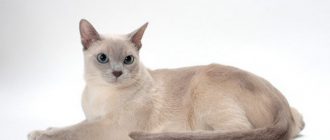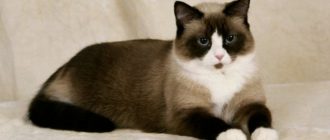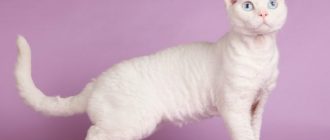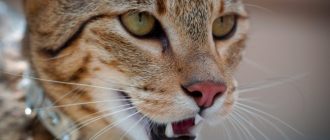Brief description of the breed
Contents
Siamese cats are amazingly graceful creatures hailing from southeastern part of Asia – the kingdom of Siam, located in Indochina. During archaeological research were found ancient manuscripts in which in addition to writing there were images of graceful cats, whose structure and color strongly resembled four-legged Siamese. It is believed that for several hundred centuries Siamese cats were akin to domestic deities – they only got to know them, and commoners could only admire these sky-eyed creatures. Today Siam, which has existed for almost 7 centuries, called Thailand. And not only the name of the state has changed – metamorphosis also occurred with the appearance of Siamese cats. Down until the mid-1950s, the breed standard implied in these animals rounded head, not so widely spaced ears, relatively short body and legs of medium length (in appearance they looked like Thai cats). But the modern look of Siamese cats is somewhat another – their head became elongated, their ears – large and wide set, and the body and limbs – elongated and taut. These cats have gained popularity in Europe – the first individuals fell on the territory of the British Isles in the 19th century, and into the Russian Empire they were imported at the beginning of the 20th century. Since then siamese breed constantly enters the top 10 most beloved cats in different countries. Moreover, interest is due not only to their exquisite exterior (according to they look like ancient Egyptian cats), but also excellent character. Siamese very quickly become attached to people, enough good-natured, smart and inquisitive. In addition, these animals often live to an advanced age – 20 years or more. But several lucky Siamese can reach the 30th anniversary, like a cat of this breed nicknamed Scooter, born in 1986 in the USA (in 2016, a mustachioed the long-liver, unfortunately, did not die). Siamese cats when looking at they give the impression of a measure of muscular and slender animals medium size. Their weight is from 3.5 to 7 kg and their body length approximately 65-70 cm. Males are usually larger than cats. Head these animals are wedge-shaped and narrow, proportional to the body, the transition from frontal part to a long nose straight. Big ears at the base wide. The eyes are large enough, almond-shaped, blue or blue color of various saturation, strabism is undesirable (strabismus). The neck is dry and long, turning into a tube-shaped elongated muscular body. The limbs are long and graceful, with small oval paws. The tail is long, narrow in diameter, without kink. The coat of Siamese cats is soft, short, fits snugly to body, without undercoat. Siamese point colors – dark (same color) markings on the face, ears, limbs and tail, the main body tone is always light – blue, cream, white with a yellow tint, light orange. By the way, Siamese are born white, and the color begins to darken around the end of the first week life (finally it happens by 8-10 months).
Siamese cat photo:

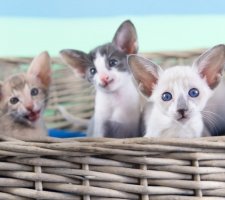



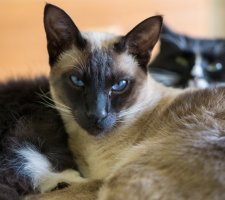
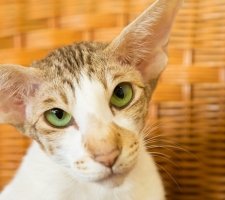
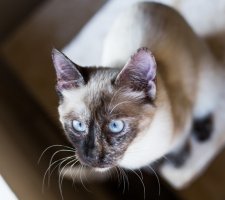
 Pictures of Dog Breeds |
Pictures of Dog Breeds |
Siamese cat story
At one time, there were a great many hypotheses regarding Siamese cat origin. Today it’s precisely known what happened breed in various Siamese ancient cities. In particular, it is about the city of Ayutthaya (the territory of modern Thailand). Once this the city was the capital of Siam. Ayutthaya was founded in 1350. TO Unfortunately, in 1767, during the Burmese invasion, fire almost completely destroyed the ancient capital. In the national the library of Thailand, located in the capital of the kingdom – Bangkok, there are ancient manuscripts describing the cat, the birthplace which was Siam. According to manuscripts, the description of the cat is fully coincides with the appearance of a modern Siamese cat. Thanks to the documents in the National Library, it was possible to establish reliably that Siamese cats lived in temples and were carefully guarded. Such precautions were caused by the desire to preserve the purebred breed. Siamese cats appreciated to such an extent that they had the right to own pets only representatives of the royal family. Most Siamese cats those distant times had a characteristic kink on the tail. Over the years he began to be considered a deviation from the norm. Breeders managed to cope with this “flaw”, although today you can still meet Siamese cats with kinked on the tail. True, this happens to stray cats, which interbreed with domestic cats. Most first representatives of this ancient breed suffered strabismus. Such the feature, of course, as well as a kink on the tail, went beyond limits of understanding the norm of appearance of cats of this breed. Thanks the work of breeders and managed to cope with this feature. Siamese cats with strabismus are now extremely rare.
Siamese cat character
A somewhat peculiar, athletic appearance of Siamese cats many people believe that representatives of this breed have somewhat detached disposition. In fact, everything is just the opposite. Siamese cats are usually very loyal to man and happy give him their love and affection. They are practically interested to everything that the owner or family members do. Representatives of this The rocks are quite affectionate. One of the features of the breed are “vocal” pet data. If the animal wants something, then maybe the impression is that the pet is talking to you.
Maintenance and care
Siamese cats in comparison with cats of long-haired breeds, such as, for example, the Persian, or Maine Coons, do not require much care. The owner will need to devote only a few hours to week for immediate grooming. Frequent wool washing can damage the hair structure and adversely affect the color animal. The same goes for combing. For removing dead hair is best to use a special soft brush, which does not harm the hair of a cat. Bathe siamese cats like you understood rarely enough. While swimming is recommended use corn starch. They need to sprinkle all the wool animal. In this case, you must be extremely careful not to starch did not get into the eyes. After that wash with massage movements wool. In other words, it can be used as a detergent. facilities. After such a bath, be sure to rinse thoroughly Wool and wipe dry. Ears require special attention. Regularly you need to make sure that they do not cause inflammation, irritations, as well as infections. Process the auricles and auditory canals with a special solution prescribed by the veterinarian. Many Siamese cat owners for a visual increase in width the ears of the pet are sheared in the ears. This procedure, in basically safe. In addition, it provides the best air circulation in the ears. Training Siamese cats does not cause special difficulties. Parenting and training can occur in different ways, depending on the individual characteristics of each pet. An important condition in the process of training and education is sequence. It is also necessary to avoid the use of rudeness, and especially strength. Each stage of training should cause the animal extremely positive emotions. Different ways to punish cause the opposite effect, for example, the animal can begin to walk not into the tray, and wherever he likes. By the way, with this problem many Siamese cat owners fight completely wrong. The main mistake is an action aimed at forced sitting pet in the tray. This will cause the animal to negative associations with the toilet tray will occur. It’s better use the incentive system in this regard. For example, after each trip to the toilet in the right place can be given to a pet goodies.
Feeding
Siamese baby under the age of 4 months should be fed at least 5 once a day, from 4 to 6 months – 4 times, from 6 to 8 – 3 times, and then you can translate the animal into a 2-time “adult” food. Already to at the time of purchase, the owner must decide which ration will be selected for a pet – a natural menu or industrial feed. Wherein you can consult a veterinarian and breeder, because their opinion quite competent in matters of nutrition and health. If the owner nevertheless decides, for example, to transfer the animal from dry finished food for natural food, this should be done gradually, otherwise avoid digestive upsets. Approximate daily the food norm for a cat is based on a calculation of 30-60 g. per 1 kg of weight animal. Whatever the diet, cat’s bowls should always be clean, ideally the cat manages to get enough for 10-15 minutes, after which is better left over food in a container for storage in refrigerator, or dispose of, and wash the dishes of the cat. Leave food for later in the bowl is not worth it, as the food may go bad, then diarrhea, vomiting, and sometimes poisoning cannot be avoided .. Always full should be a bowl for water, especially in hot time.Natural nutrition. The basis of natural feeding – proteins of animal origin, or rather meat. The best thing to get lean beef (veal), rabbit for a cat, lamb, turkey. The meat is given to the cat daily in shredded on small pieces of the form, preheated. Before meat should be processed – boil, freeze for several days or scald with boiling water to exclude helminth infection. Dishes from sea fish are not cooked more often 1-2 times a week – cod, saffron cod, hake (before serving the cat fish is either boiled or thawed, removing bones). Offal can be given no more than 2 times a week, giving preference for thermally treated liver, kidney, lung. TO rich in protein foods as a kind of garnish add raw, boiled or baked vegetables (carrots, zucchini (or zucchini), cabbage (white cabbage, broccoli, kohlrabi or cauliflower), pumpkin). Vegetables chopped with a knife into pieces or grind into mashed blender, season with a small amount of vegetable oils (linseed, olive or others) and mixed with meat (fish or offal). By the way, you can give fruits – seasonal apples, pears, but tailed seldom love them. Usually alternate vegetables with cereals (rice, buckwheat, oatmeal), as well as bran. Chicken and quail eggs can be added to main courses no more than 2 times per a week. Treats for cats – fermented milk products (sour milk, fermented baked milk, varenets, kefir, cottage cheese, milk – only to kittens), they You can treat purr daily. It should be purchased low fat products, always fresh, made from natural milk and without flavoring. In natural nutrition should not be spices, smoked meats, salt, sugar. Do not give the cat a river fish (especially raw), sausages, fruits and vegetables, causing fermentation (grapes, beets, eggplant, green peas) and allergies (all types of citrus fruits), bones (any), sweet carbonated and alcoholic drinks, chocolate. Can be grown (or buy at a pet store) sprouted oats (wheat) for purrs. Mandatory with natural feeding courses of vitamins. Ready stern. Industrial power has many opponents, because it’s not clear what really lies in the pack. The worst option is feed economy class, which are clogged with store shelves. They do not include only very little meat (and often disguised as meat offal, skin, feathers, other waste), but also high content artificial preservatives, flavor enhancers, GMOs. Low grade feeds contain addictive additives, which is why the animal happy to eat them. Unfortunately, many owners have lost their tailed comrades due to unscrupulous manufacturers industrial feed, covered with bright advertising. therefore preference should be given to holistic and extra-premium feeds (in their composition the largest percentage of quality meat is up to 80-90%). However, good dry and canned foods are a balanced and complete diet that does not require vitamin additives. Some Siamese cats do not differ heroic health, therefore, with the consent of the veterinarian, you can choose for them therapeutic (for problems with the kidneys, gastrointestinal tract, for example) or specialized (for couch potatoes, elderly, nursing, neutered / sterilized, etc.) feed.
Health and Disease
Siamese cat is, in general, a healthy pet. Average her life expectancy is about 15 years. Neither less there are certain ailments that are more common in others representatives of this breed. So among cats of the Siamese breed sometimes hair loss occurs, which can lead to receding hairline. Most often, the disease appears as a result of stress. In kittens respiratory infections are also common. That’s why young growth is recommended to be kept in a dry, warm room without drafts. Another issue that may arise is cardiomyopathy This ailment leads to a violation of normal delivery oxygen in the blood. A sign of the disease can be fainting. Vestibular disease, although less common, may still meet. It consists in the defeat of the nerves in the ear, leading to dizziness and, accordingly, problems with normal movement. It should also be noted that Siamese cats are often particularly sensitive to anesthesia.

